The Hidden World of Tiny Titans: 2mm Pinfire Guns History
The history of miniature firearms counts more than three hundred years. Men’s love for toys endures even as they grow older. Especially if the toy is cute and dangerous at the same time. Initially, the production of small firearms was considered a measure of craftsmanship. If an artisan could create precise miniature copies of guns, he was revered as a master craftsman.
A miniature pistol is the perfect accessory for those looking to add a touch of luxury to their collection. This small-sized gun has gained popularity among the elite as a high-end item. It was commonly given as a gift to a dignified person, such as the Queen, or to display social status. Pinfire handguns chambered for 2mm bullets are typically around 2 inches in length and are capable of reaching bullet speeds of nearly 1000 feet per second. Various models are produced in limited numbers as collectibles. The Berloque pistol is the most popular 2mm pinfire gun. An overview of its history is warranted.
Berloque Guns
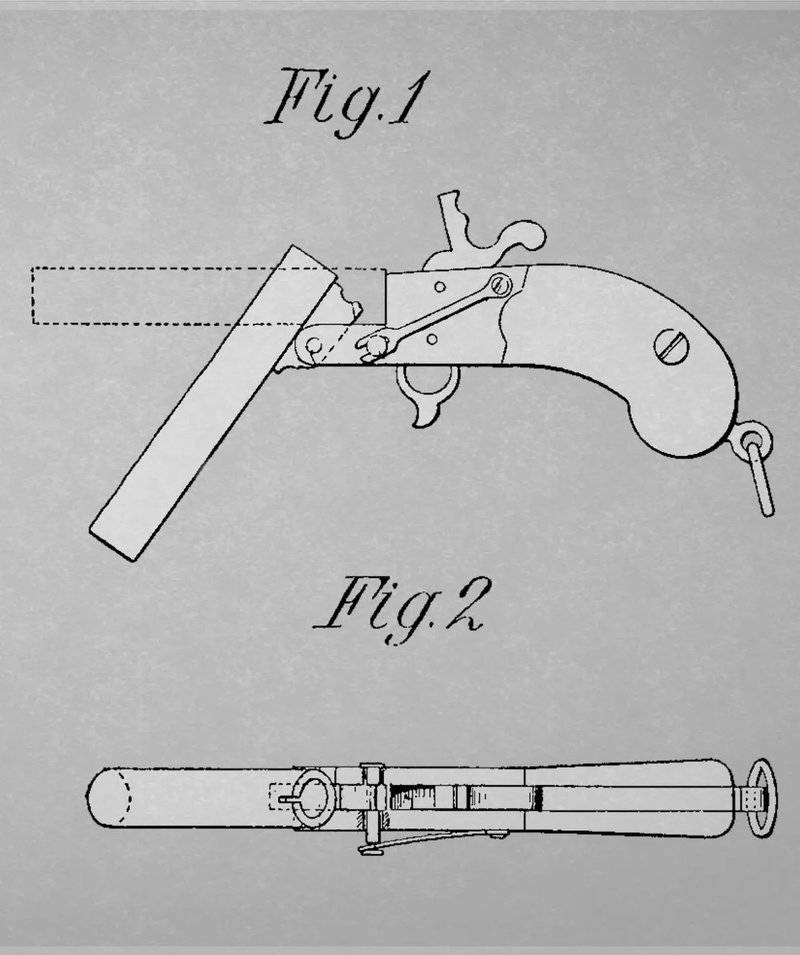
These firing devices are one of the world’s smallest working pistols. The Berloque miniature were first brought to the general public’s attention in 1910 through a German catalog. An alternative to “Pistolet Breloque” was featured in the French catalog a few years earlier. “Tiny pistols” was used to describe small guns often worn as a fob watch pendant. It is believed that the first Berloque single-shot pistol, which used pinfire cartridges, was developed by Austrian watchmaker — Franz Pfannl.
He designed some small decorative arm models and personally started their production. He emphasized the complicated construction of his models because of his essential specialization, rather than milling or casting like other manufacturers. The craftsman in question was a skilled gun designer and a master of engineering. In addition to designing his pistols, he also created the machines and tools necessary to manufacture them precisely and efficiently. This level of dedication and expertise allowed him to produce firearms of exceptional quality that were highly sought after by discerning customers. It was a true testament to his ingenuity and passion for his craft.
Franz Pfannl patented his creation in 1899. Austria is often called the Motherland of Berloques, a popular type of charm or trinket usually attached to bracelets or necklaces. The first picture shows the earliest Berloque pistol designs, corresponding to the diagram in Franz Pfannl’s July 24, 1899 patent. As with many of the earliest guns, the barrel pivot is a screw rather than a rivet. The grip design is unusual and has not been encountered in any of the later guns produced by Pfannl.
The first mention about Berlogue in German gun catalog, 1910
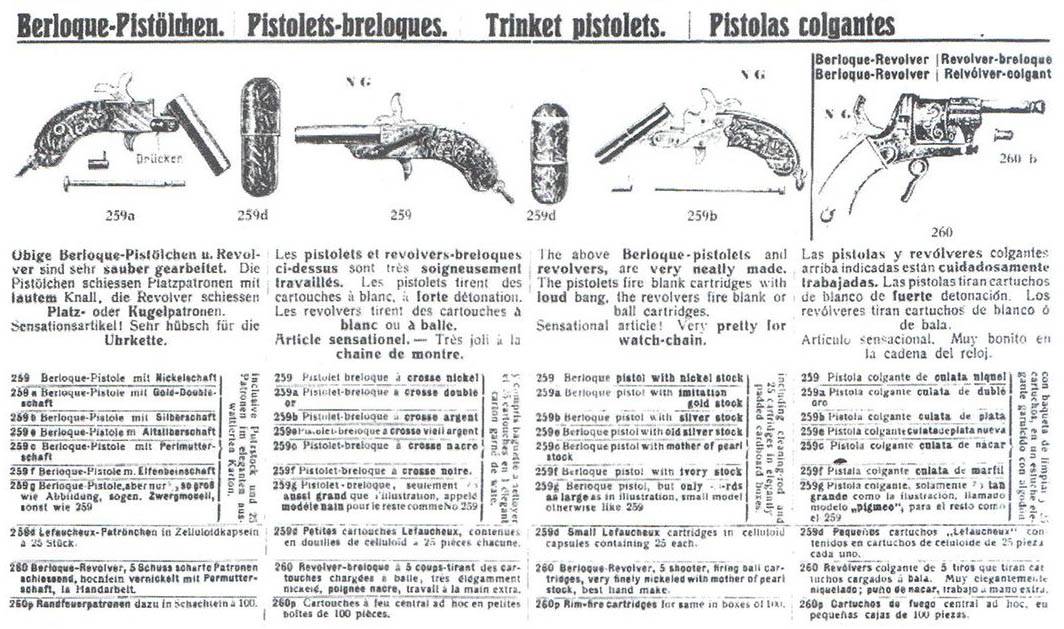
Since 1905, many Austrian manufacturers, such as Gerhard Göbharter Company, have produced these firearms in their own varieties.
Usually, these pistols were designed to fire blanks, but some advertisement versions also mention the ability to fire lead balls and bullets. Now, these models are antique and have value primarily for collectors.
After 1938, Gerhard Göbharter started manufacturing new models, which worked as single-shot flare pistols. Germany and Japan are also well-known as the countries that produced Berloque guns from the 1930s.
Early German firearms were typically made of solid nickel and silver and had thicker side plates than Austrian or Japanese guns, often nickel-plated and made of steel or brass.
The other difference is that German handguns don’t have combination breech blocks; instead, a tab is bent over from the side plate. They also usually don’t have detachable grips; grip patterns are stamped into the thick sides of their construction.
All of them have barrel latch pins and side springs. The German manufacturers have made significant efforts to produce goods of superior quality.
The Japanese types of guns were distinct from the finely made Austrian firearms. They were usually made from three layers of brass. Their barrels were held in place by friction, sometimes produced by a dimple on the barrel mount.
In earlier models, it was assisted by a small spring, which also served as a breech block. The barrels of these first Japanese versions were drilled through.
Later, they were redesigned, and later models have plugged barrels vented to the side. This type of barrel makes it impossible to fire live cartridges; only blanks can be used.
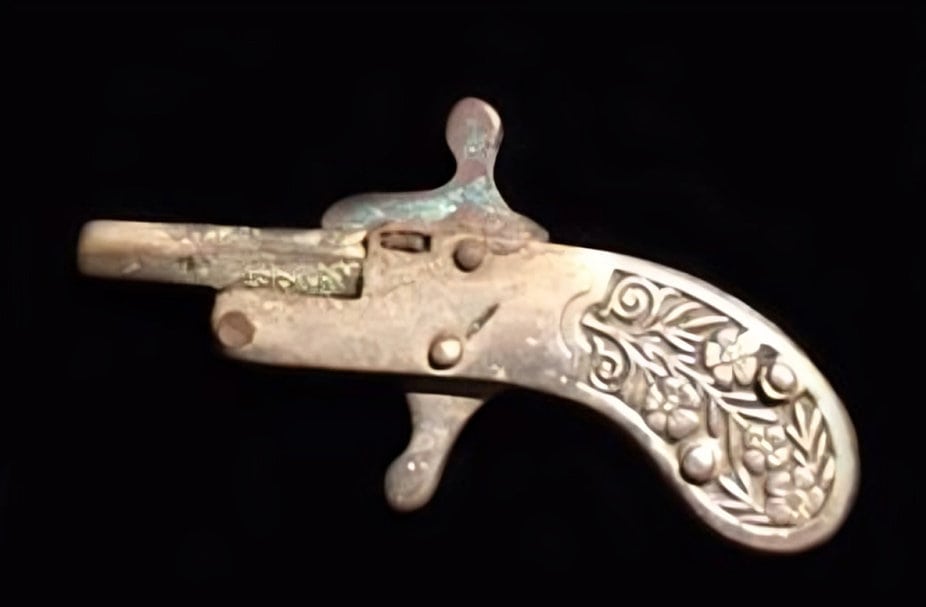
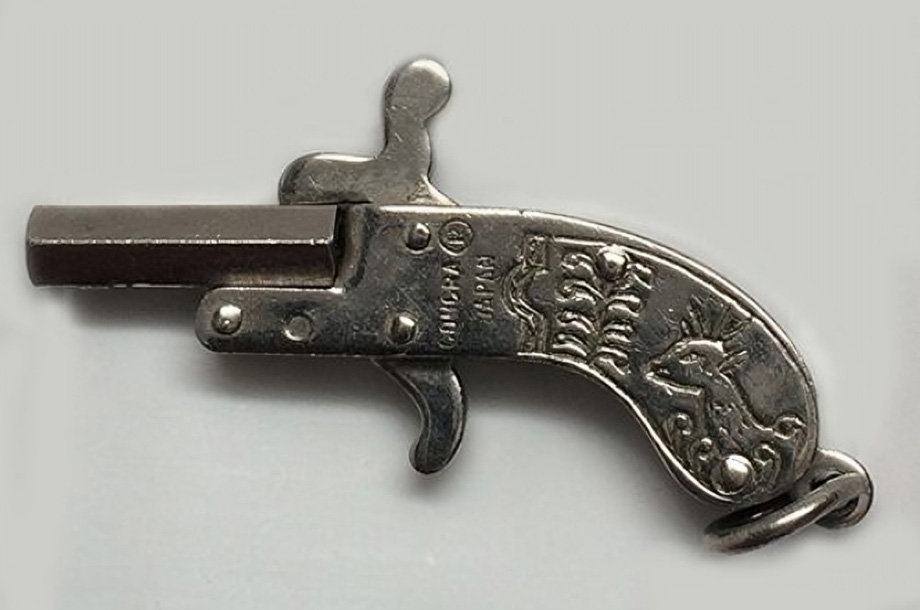
Today, the only model still being manufactured is the Berloque pistol flare kit. It is produced by Gerhard Göbharter’s descendants in Austria. The Berloque flare kit is a fantastic way to add some excitement to your parties or birthdays. It produces stunning fireworks that are sure to impress your guests. The pistol is made of brass and represented in two variations: golden-plated or nickel-plated. It has grips stamped with hunting themes. The kit consists of 2mm pinfire blanks (for launching the flare), nine signal rockets, and one 9 mm removable nozzle where the flare should be inserted.
No live ammo has been officially produced for these modern Berloques, as they are used as signal or flare guns. Still, they can shoot live ammo. With a through-barrel, this gun can fire the round-top and flat-top live cartridges. But it’s not advised: the barrel wears out fast enough, and the weapon becomes worthless. This pistol is quite affordable and starts at around $70. You can purchase the flare kit and antique Berloque variations from a few online stores.

Miniature pinfire revolvers
Let’s discuss multi-charge handguns that are more sturdy and reliable. They were produced in the late 1800th and early 1900th in France, Belgium, and Germany and wore the name that we have already heard: Berloque (by the way, one of them you can see in the ad from the German catalog above, beside Pfannl’s pistols). Their price then was about 30 Reichsmark, which was a small fortune. Today, they are the rarest of antique 2mm pinfire guns and the most beautiful and intricate. They have a six-shot double-action mechanism. Usually, they are made of steel and covered with decorative finishes: nickel, silver, and gold. Their metal parts feature exquisite hand engravings, with grips made of pearl or ivory.
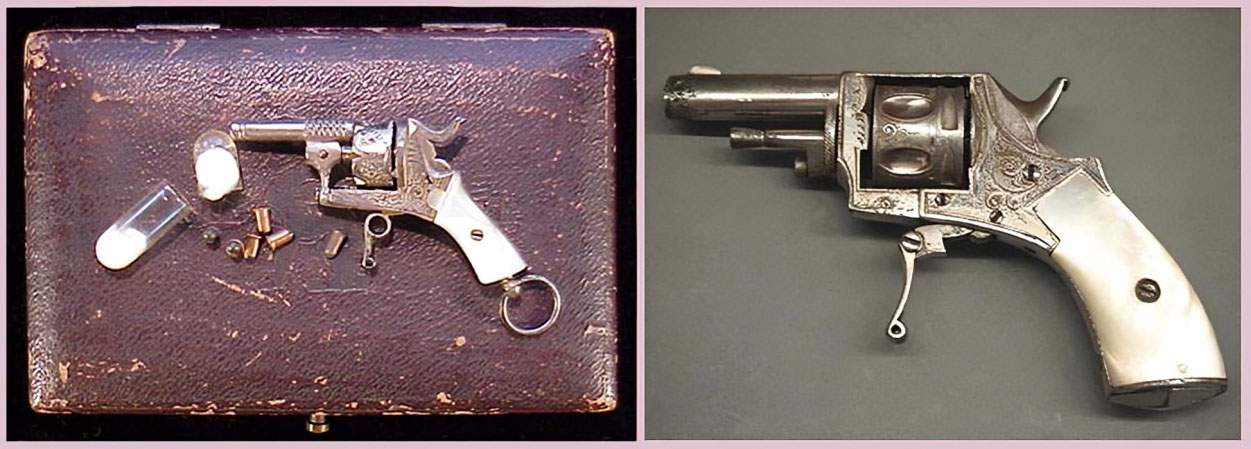
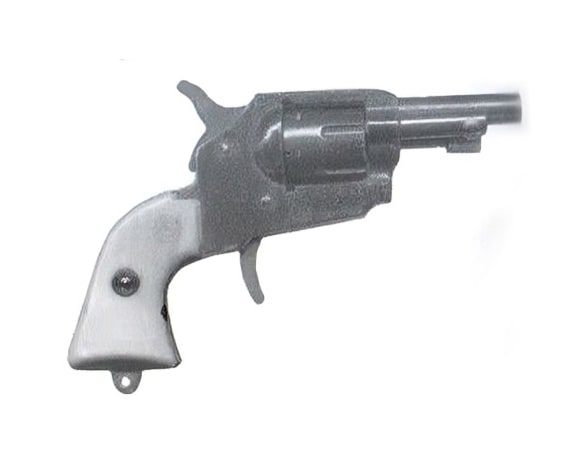
It is known that Franz Pfannl also produced a double-action miniature revolver, but we don’t have many specimens today. Due to high manufacturing costs, it had probably never been mass-produced. However, this particular market segment was not left unoccupied. A German arms manufacturer, Herbert Schmid, started producing these revolvers in Berlin, using parts supplied by Pfannl. Interesting fact: he is Pfannl’s countryman and many other German and Austrian armorers who made miniatures. So we see how Pfannl’s talent influenced people around them, which helped his ideas to find their embodiment even without his direct participation. It seems that Schmid stopped manufacturing these pistols in 1940th. The other watchmaker and armorer, Mr. Tschech, has not missed his chance.
The Xythos
Notably, the most commonly known 2mm pinfire guns were initially developed in Austria. The Xythos automatic revolver was developed by Andres & Dworsky watchmakers’ company at the end of the 1950’s. Mr. Tschech, the creator, was inspired by the legendary Colt Python. The first pre-production model of around 90-120 examples was made in 1959. Guns had brown grips, silver-plated metal details, and a gold-plated trigger. The version edited and accepted later was far superior to the original. Tschech needed a special crew to assemble guns for mass production when the market was ready to receive them.
As a watchmaker manufactured the gun, its parts were stamped precisely from thin brass, layered, riveted, and plated in gold, silver, or nickel. It also has an exciting design: the barrel with the front half of the seven-chambered cylinder should be hinged down for loading. Only six of the seven chambers can be loaded: the last one had a permanent pin in it to align it with the back half of the cylinder – which is rotated by hand.
This is the only known accurate 2mm pinfire 6-shot revolver from the ’60s. In 1970, Andres & Dworsky got a patent for the Xythos. After that, they changed a 9-ridge swept-up hammer to a 9-ridge straight-up hammer, which became closer to the original design of a full-size revolver. The gun was last modified in 1999.
The Xythos pinfire revolver has become an object of great interest for many collectors due to its unique history. This particular gun is no longer being manufactured, contributing to its growing popularity among collectors. Its innovative design made it a sought-after weapon and is now considered a highly collectible item. The Xythos pinfire revolver is a testament to the evolution of firearms and a piece of history that continues to intrigue and captivate enthusiasts worldwide.
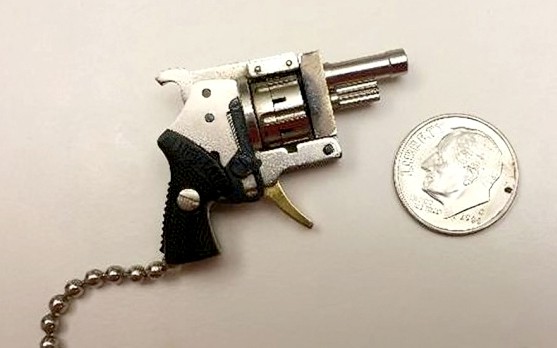
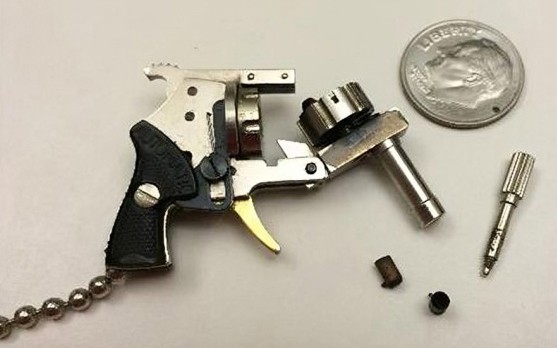
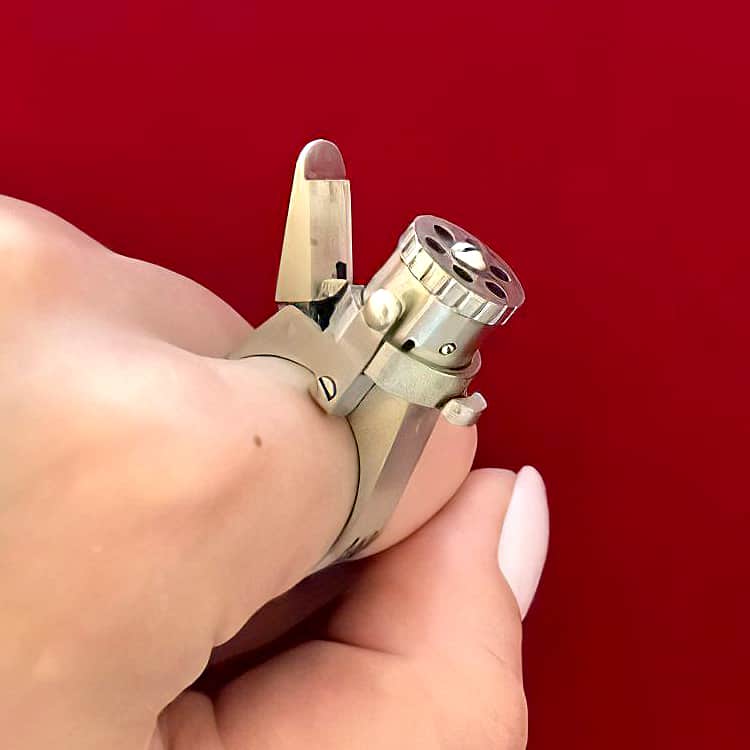
We should mention such exciting and original decisions as a revolver in a ring about miniature revolvers. Such items were popular at the end of the 19th century. Women purchased jewelry designed to look like a charged revolver, despite its lack of impressive strength and potential safety hazards, because it made them feel like Femme Fatales.
The fashion trend that was popular in the past is making a comeback now. So, in some online stores (including our site), you can find shooting rings: the cylinder with cartridges is where the precious stone is usually fixed. It looks really cool! If you want to learn more about this model or buy one — you can do it now.
And what about present-day 2mm pinfire guns?
Larry Smith, a popular American craftsman, created some of the finest miniatures available. One of his limited edition works is a Derringer pistol with a caliber of 0.44″ (11.2 mm), which was also the firearm that killed President Abraham Lincoln. Derringer is a generic term for any compact, easily concealed pistol used by women due to its small size.
Bob Urso is another well-known American craftsman and miniature firearms collector. Some of his pistols are made for sale, and some are designed just for his own collector’s pleasure. It is one of them. This 2 mm pinfire one-shot pistol is called “Tiny Derringer” or “Irish Derringer.” The master says its prototypes are all brass Irish Knuckle Duster Derringers. The minor variant is made of steel; it is nickel-plated and has a round, purple-hearted wooden grip.
Some people say the Irish Derringer is the world’s most miniature 2 mm pinfire gun. For this caliber, it can be true. But, generally speaking, today, the market of miniature firearms has much finer pistols of this type.
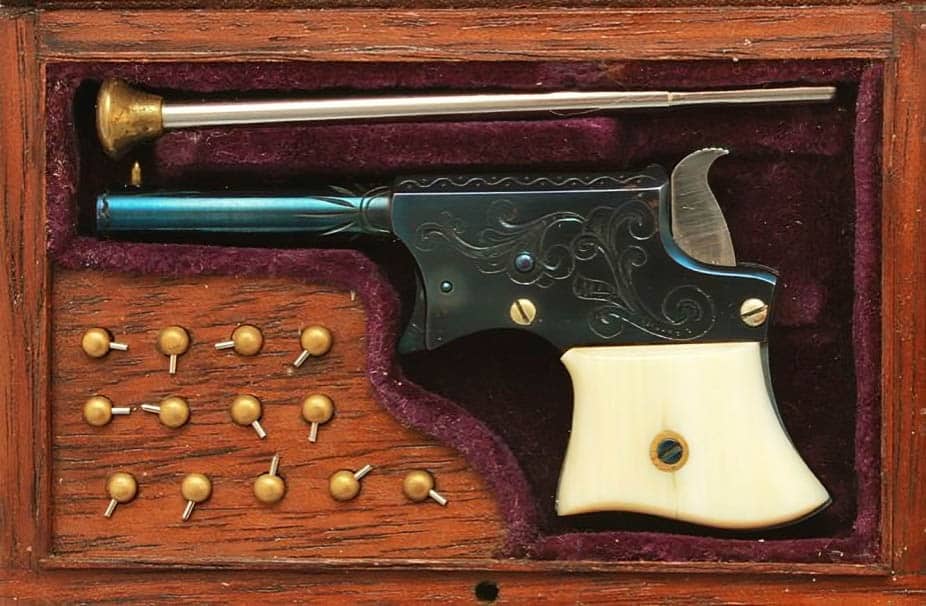
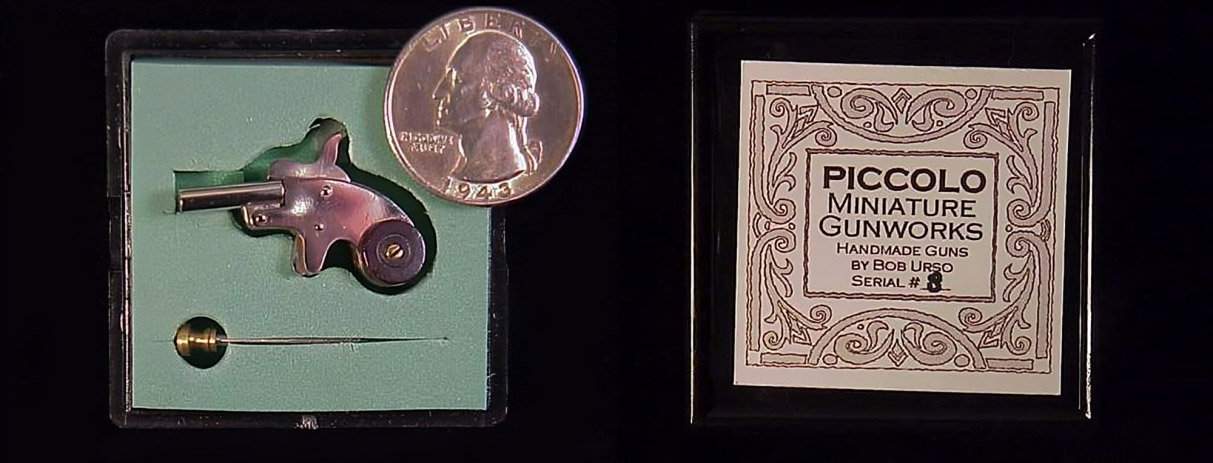
Our own tiny Derringer
People always try to achieve the impossible. Human nature is an eternal race with itself. The fastest, the strongest… the smallest.
Miniature firearms are popular among collectors and make unique gifts. They’re also a nostalgic reminder of childhood and a tribute to real-life firearms. They offer a glimpse into the world of miniature guns.
And without too much modesty, we would like to show you our own matter of pride: the Miniature Derringer, which is made of 14K gold and even has unique exclusive material in its grips: mammoth bone. Its caliber is only 1mm, and still, it fires and even pierces metal sheets! Watch the video below to make sure we are right.
If you are interested in purchasing this firearm, please do not hesitate to contact us. You can find more information about this model and its pricing here:
About the Author
My name is Olha Polah, and I have been working in miniature weapons production since 2015. I started the mini firearms brand and have been running the brand’s Instagram page since 2016. The brand’s miniatures are popular worldwide, with fans in 25+ countries. I became the sole owner of the brand in 2018 and created a comprehensive line of miniatures. More than 60 models of miniature weapons from various historical periods have been created. In November 2023, I was interviewed by Robert Dunn for the GunTech magazine, where I talked about the hardships I had to endure in my business. I also run a newsletter for the brand’s customers, which has evolved into a full-fledged magazine with in-depth articles published on the wpolah.com.

My mission is to make people’s lives more joyful by sharing interesting facts about miniature weapons and inspiring everyone to express themselves.
